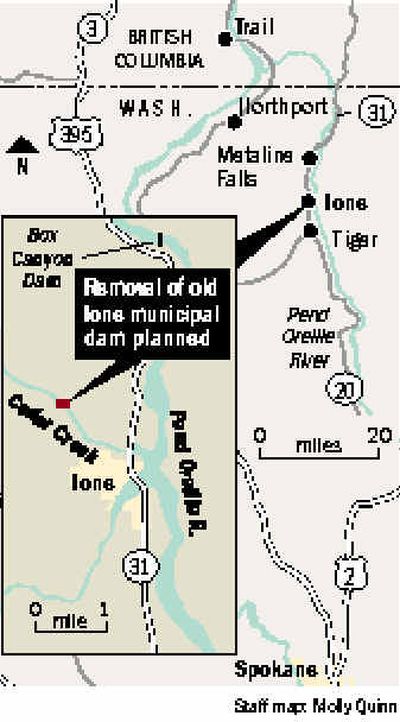Ione gets funding for dam removal

Demolition of a 19-foot-tall dam on Cedar Creek in northern Pend Oreille County is to begin next summer. Its removal will restore fish habitat and keep the 53-year-old structure from breaking and washing away downstream residents.
The concrete dam, about 1 1/4 miles from the creek’s confluence with the Pend Oreille River, used to collect domestic water for the town of Ione. It hasn’t been used since 1988, when the town began getting its water from wells.
The $853,110 removal project will be paid mostly with a $725,144 grant awarded this month by the state Salmon Recovery Board. Various local, state and federal agencies will pay the balance with cash and in-kind services.
The Salmon Recovery Board distributes state and federal money for the benefit of threatened and endangered fish. In this case, the money will provide a dozen miles of prime spawning habitat for bull trout and west slope cutthroat trout.
The grant also provides relief for the town of Ione, which had faced the threat of fines up to $100 a day for failure to repair or remove the 95-foot-wide concrete dam, which impounds more than 10 million gallons of water.
State Department of Ecology dam safety experts said the dam was in danger of collapse because of erosion where it abuts a limestone cliff. The danger was reduced last fall when the department gave the town $3,500 for emergency repairs.
The reprieve was temporary, however. State officials said the town still would eventually have to tear down the dam or bring it up to modern standards. A consultant told town officials the repairs would cost about $350,000, not including a $300,000 fish ladder that likely would have been required.
With only 425 residents, Ione couldn’t afford any of its options. The town had twice been turned down for a dam-removal grant from the Salmon Recovery Board when the temporary repair was performed.
This year, though, Ione and the Pend Oreille Conservation District won $924,442 worth of Salmon Recovery Board grants for three projects.
In addition to the Cedar Creek dam removal, the Salmon Recovery Board awarded money to the conservation district to assess fish migration barriers, such as road crossings, on more than 100 miles of streams that drain into Idaho Priest River watershed from Pend Oreille County.
The board also will pay much of the cost of a conservation district project to install fish screens on irrigation diversion structures on Indian Creek in central Pend Oreille County.
Together, the conservation district projects will cost an estimated $250,614, of which the Salmon Recovery Board will pay $199,298.
The U.S. Forest Service, the U.S. Department of Fish and Wildlife, two land owners and the federal Landowner Incentive Program will pay the balance.
Sandy Dotts, a watershed steward for the state Department of Fish and Wildilfe, was to deliver a Salmon Recovery Board check for the Cedar Creek Dam removal to the Ione Town Council Wednesday night.
“It’s been a long time coming,” said Councilwoman Leanna Powers, the town’s water and sewer commissioner.
Work is expected to begin in July, if various permits are issued soon enough, and be completed in October or November, Dotts said.
The first step will be to divert the creek around the dam so the work site can dry out. Then as much as 26,000 cubic yards of sediment – enough to fill 2,600 dump trucks – must be hauled away. After the dam is removed, the creek banks will be fenced and riparian vegetation will be restored, Dotts said.
A related project, funded by the state Department of Fish and Wildlife, removed an even older Ione municipal dam this past summer. An old log “crib” dam about halfway between the concrete dam and the Pend Oreille River was removed with the permission of the land owners.
Powers said the 5-foot-tall wooden dam was used to supply Ione’s domestic water until 1910, when it was replaced by another wooden dam at the site of the current concrete dam. The second wooden dam was torn down when the concrete dam was built.